Managed Detection and Response
Managed Detection and Response is a service that you can obtain from Kappa Data that ensures 24x7x365 detection, response and recovery of cyber threats and incidents.
What is Managed Detection and Response?
In today’s rapidly evolving cybersecurity landscape, organizations face an increasing number of sophisticated threats that can compromise sensitive data and disrupt operations. Managed Detection and Response (MDR) has emerged as a critical service for businesses that need to monitor their networks 24x7x365. Gartner recommends MDR as an essential solution for organizations, particularly those with limited in-house resources, to effectively detect and respond to cyber incidents in real time. MDR services offer continuous monitoring, threat detection, and rapid incident response, helping companies stay ahead of potential attacks.
For companies operating in Belgium, MDR is not just a strategic investment but also a crucial component of compliance with the NIS2 Directive (Network and Information Systems Directive). NIS2 mandates that essential and important entities across the EU, including those in Belgium, implement robust cybersecurity measures to protect critical infrastructure. MDR services provide a proactive approach to meeting these regulatory requirements, ensuring that organizations can promptly identify and mitigate cyber threats, thereby reducing the risk of significant financial and reputational damage. By leveraging MDR, companies can enhance their cybersecurity posture, comply with NIS2 regulations, and safeguard their operations in an increasingly complex digital environment.
For whom is Managed Detection and Response for?
Small to medium-sized businesses (SMBs) or even larger enterprises that do not have a dedicated cybersecurity team often struggle to detect and respond to advanced threats. MDR provides these organizations with access to expert security professionals who can manage and respond to incidents around the clock.
High-Risk Industries
Especially, companies in sectors like finance, healthcare, energy, and government are frequently targeted by cyber criminals due to the sensitive nature of their data. MDR is crucial for these industries as it offers comprehensive threat detection and response capabilities, ensuring that any potential breach is swiftly identified and contained.
When 24x7 detection & response is not possible
Companies that require continuous monitoring of their networks and systems, but lack the resources to maintain an internal team that operates around the clock, benefit greatly from MDR services. This is particularly important for businesses that operate in multiple time zones or provide critical services that cannot afford downtime.
In most cases, organizations do not have the financial and practical resources to have their own Security Operations Center. A Security Operations Center cost a lot of money as an infrastructure, but is as well difficult to maintain a team of cybersecurity specialists that operate 24×7 during the whole year.
Hackers are usually active on moments where nobody works, like during the night or during the weekends, as shown by the graphic offered by the security reponse team of Sophos
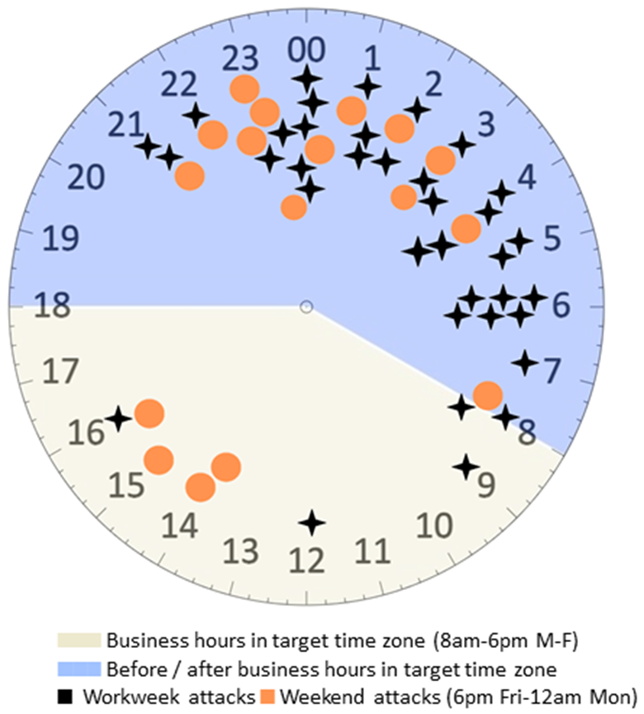
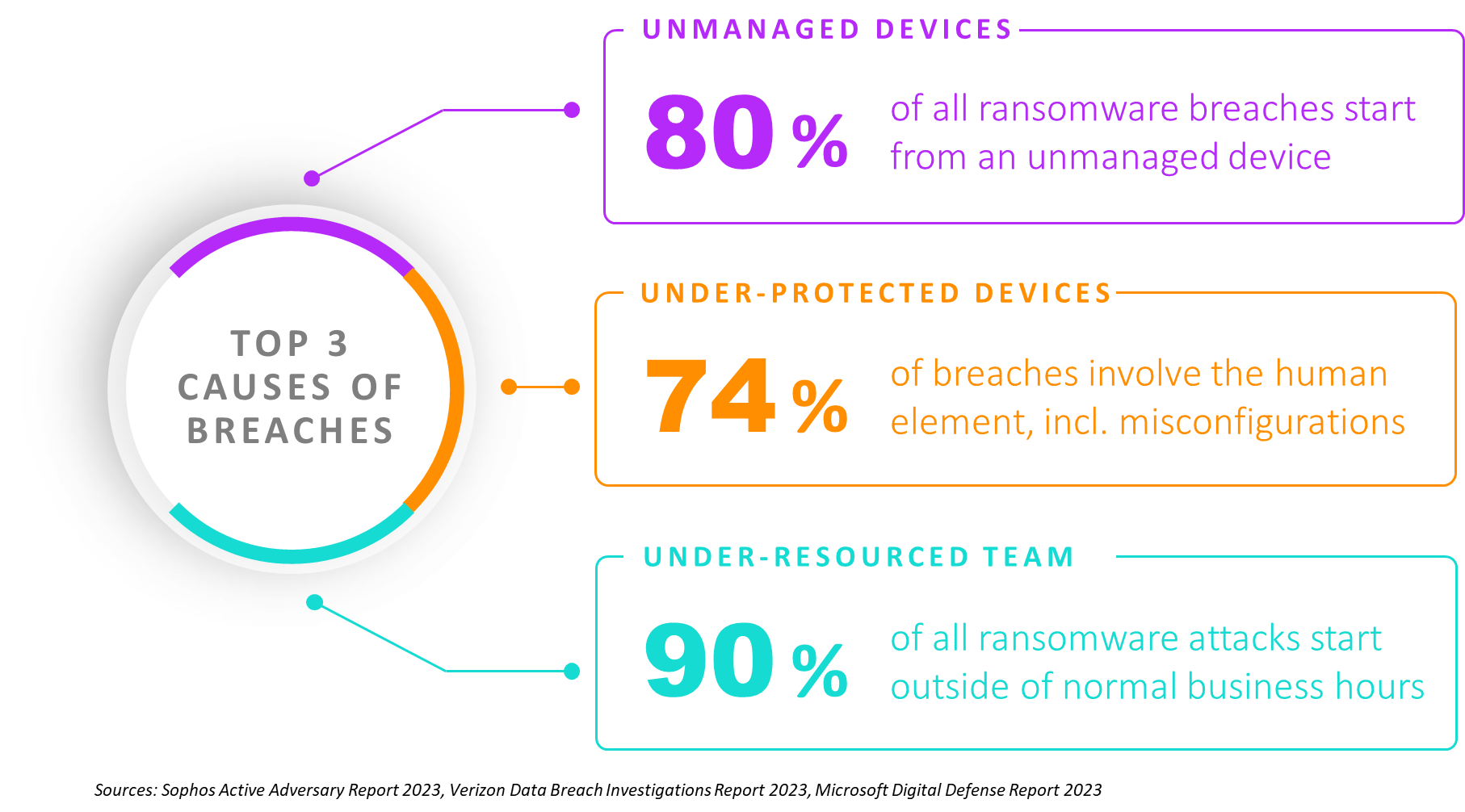
Top 3 breaches
Having no resources for protecting the network, could easily lead to breaches into the network. Sophos Active Adversary Report of 2023 shows clearly in their top 3 breach study that under-protected devices and unmanaged devices are often the cause of a breach. Out of every attack Sophos has seen, 90% off all ransomware attacks started with under-resourced teams.
Companies that are NIS2 compliant
More than 2.000 companies in Belgium will need to be compliant with the NIS2 law from the 18th October on. This means that they need to have an incident response plan ready, whenever a cyber incident occurs. Because business continuity needs to be ensured, after an attack, companies have no choice to have their own security team 24×7 ready or need to use Managed Detection and Response services.
Cyber Insurance
The demand for Cyber insurances increases as well, but are becoming also harder to get. Because of the complexity of the IT environments and evolving techniques of hackers, Insurance companies are asking an incident response team as return.
Offering Managed Detection and Response
Kappa Data offers Managed Detection and Response by two suppliers; Barracuda XDR and Sophos MDR. Since Barracuda XDR is already handled, we will mainly focus on this page of the services offered by Sophos.
Sophos Ecosystem in security controls
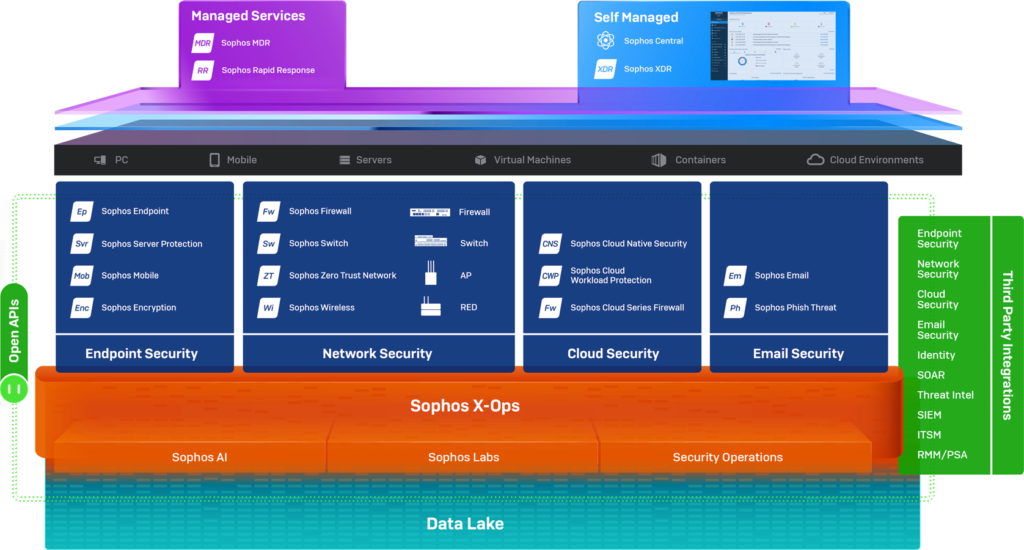
Sophos offers its own ecosystem by providing solutions for PC’s and servers, Mobile devices, Virtual Machines, Firewalls, AP’s, Containers and Cloud Environments. All these solutions are connected to 1 Sophos Central platform for central management, but also interconnected. This interconnexion is also call Synchronized Security.
With Synchronized Security, there is already an automated way of detecting and responding anomalies and threats. Whenever a device is infected by a malware for instance, this devices will be isolated and lateral and vertical movement will be blocked.
As shown above, everything is connected with a huge datalake where metadata is stored and where the Sophos Security Operations teams and labs are connected to. This datalake can be defined per customer and can be expanded by several integrations of external platforms.
Sophos integrations with external systems
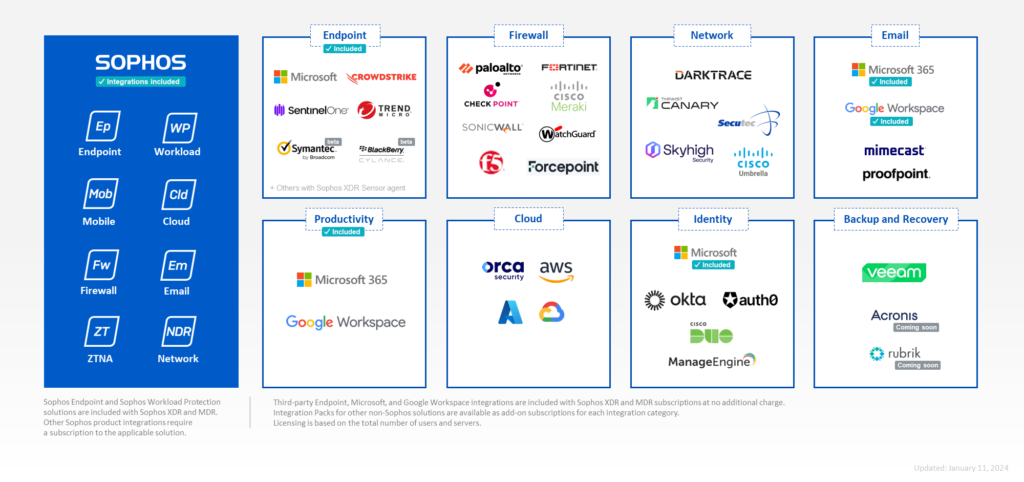
Besides the own ecosystem of Sophos, different external systems can have a feed to the Sophos Datalake where alerts are transformed to the Sophos alerting systems. Every brand has its own alerting methodology, so transforming every type of alerting towards the Sophos alerting system needs to take place first. A feed metadata of each external device is provisioned via an API.
As shown in the picture above, no additional costs are charged when you have bought Managed Detection and Response licenses for Microsoft and Google Workspace environments are required.
How the Sophos MDR team operates
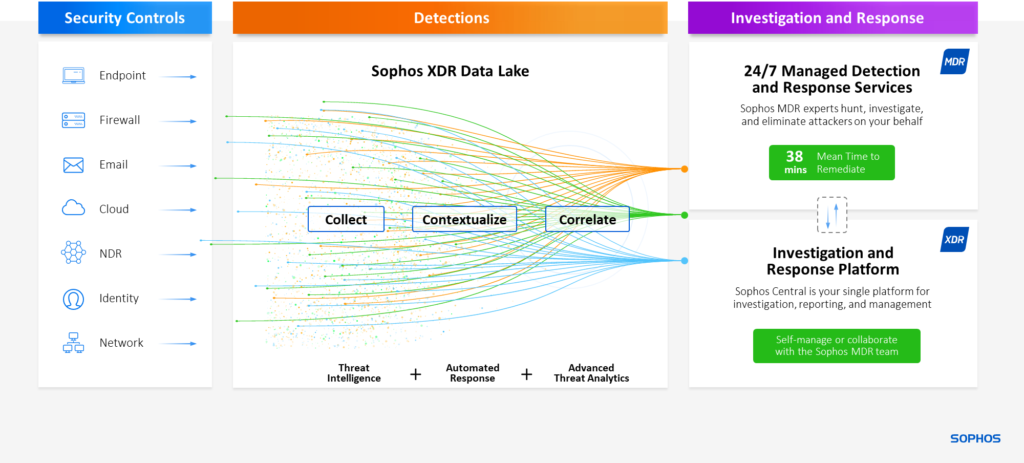
In the image above you have on the left the security controls like endpoint, firewalls and other devices that generate all the metadata. This metadata is collected in the datalake, where AI gives context around the information that is collected. Sophos AI engine will then correlate all this data and present the results to the Sophos MDR Team.
Analysis of the correlated information
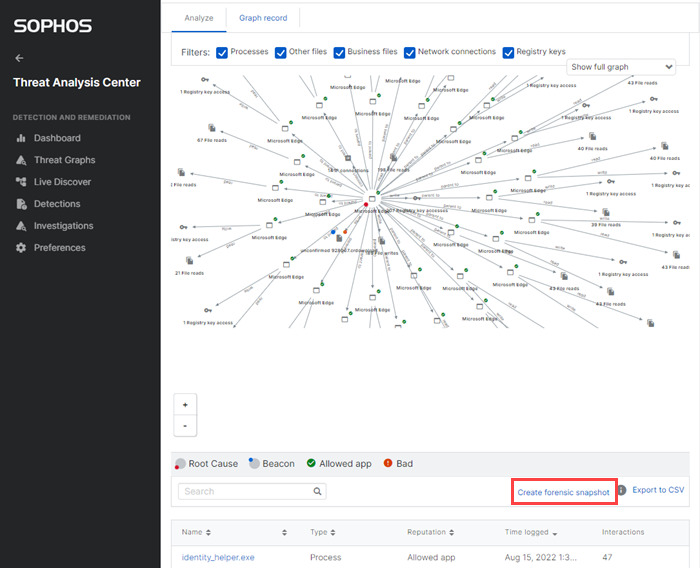
In Sophos Central a Threat Analysis Center shows the different processes and actions made by a possible hacker in a Graph. Based on the type of licensing, Sophos can search via its XDR Tools the root cause of the incident, so that future attacks via the device are avoided.
The Sophos MDR team uses the XDR tool that is connected with the Mitre Attack Enterprise Matrix, together with its own threat hunting to tools in order to make the right conclusions.
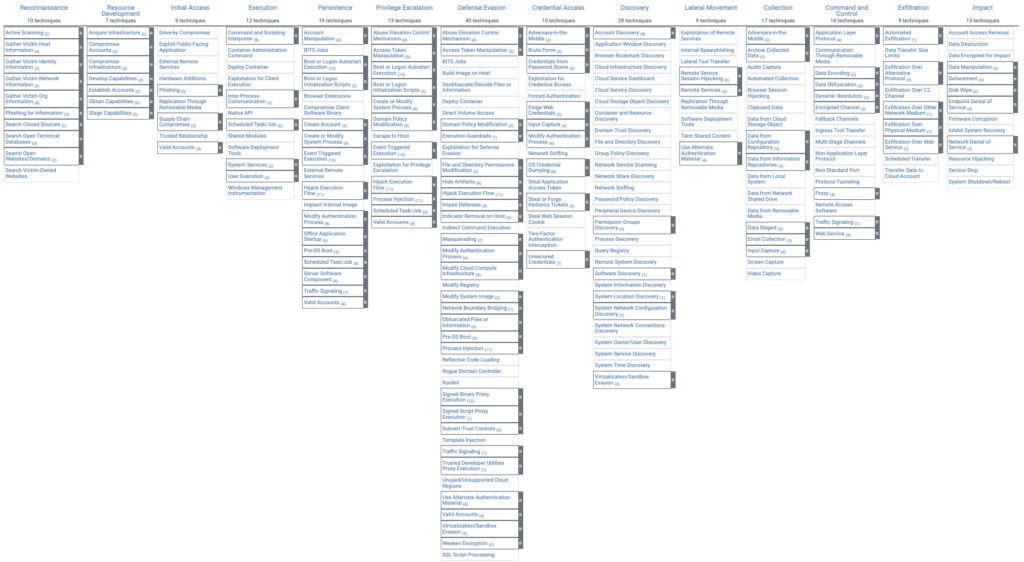
Incident Reporting
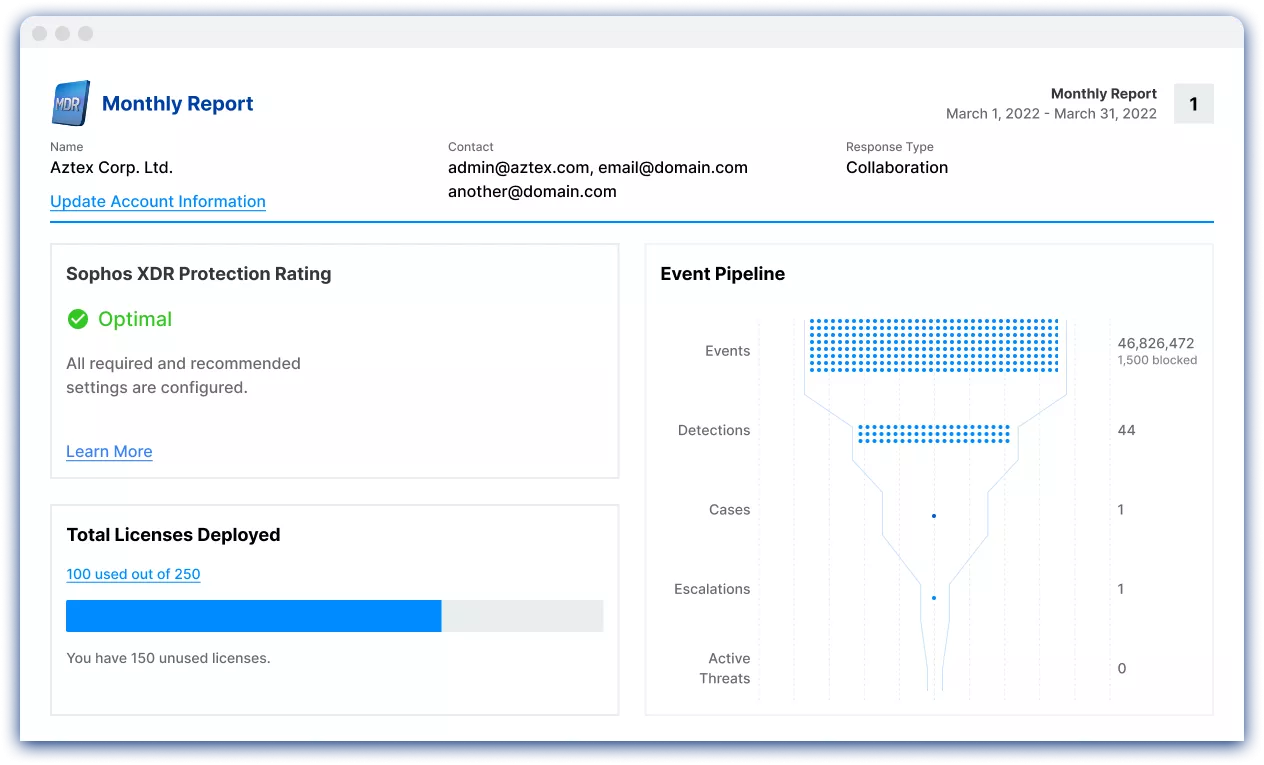
With Sophos Managed Detection and Response, you can choose you wish to have weekly or monthly reports. This reports can then also be used in your own report towards CCB Belgium.
Why use Sophos Managed Detection and Response
We already discussed the need of Managed Detection and Reponse in the beginning of this article, but Sophos offers these MDR services to companies that have a security team, during the office hours, or don’t have a security team at all. In both ways, Sophos offers these services in a collaboration modus or a full authorized modus.
In a collaboration modus, Sophos does the detection and the threat hunting part where the alerts are communicated towards the IT-partner. The full authorize mode is applied when Sophos is authorized by the customer to respond and remediate whenever the IT partner or customer is not available to respond.
Managed Detection and Response is already a mature concept at Sophos. Today Sophos monitors more than 23.000 networks worldwide with a cyber security team around 600 specialists.
Due to the extensive experiences in threat hunting and restoring cyber attacks, Sophos measures the performances of their team. These measurements gave as well some exceptionnal results :
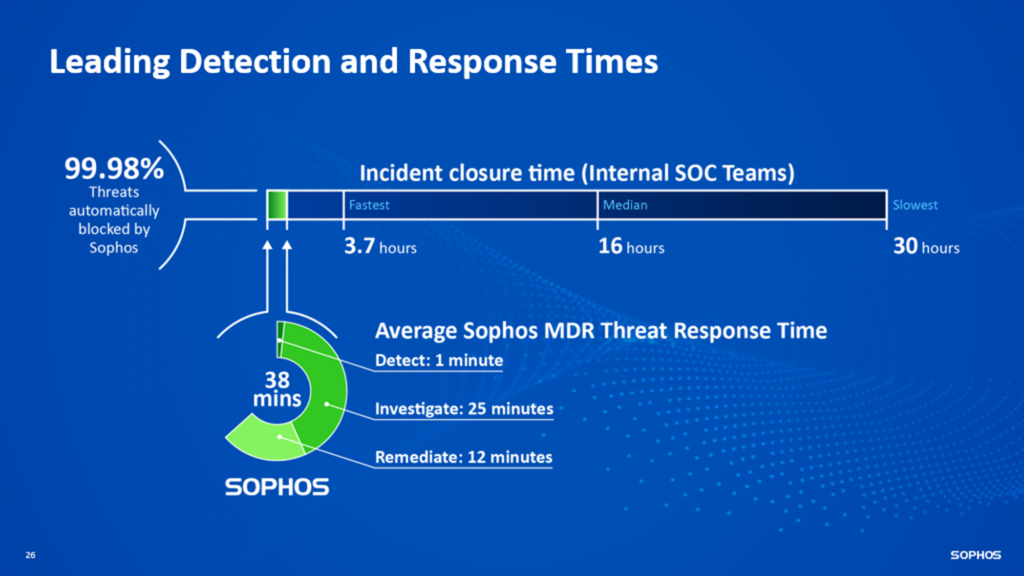
Integration with non-Sophos devices
As already discussed, a lot of integrations are possible with Sophos MDR. Whenever a customer is using for example Microsoft Defender endpoints, an XDR sensor collects the information of Defender in the Sophos Datalake. In this way you don’t need to replace Microsoft Defender with Sophos Endpoint. The same goes for other brands.
Security team at your disposal
With Sophos Managed Detection and Reponse licences you get a dedicated security engineer at your disposal with a backup of a whole team that exists out 600 people worldwide. This team of cybersecurity experts will help you with the right configuration setup of your security points (internals as external). As soon this has been accomplished the Sophos Security team monitors your network environment.
Warranty when incidents occurs
With Sophos Managed Detection and Reponse Complet licences, you get a warranty of 1000$ per device that is protected by Sophos, with maximum amount of 1 million dollars.
This warranty, in case of a breach, included a range of costs like notification costs, PR, Legal, Ransomware, etc. More information about this warranty can be downloaded via the button below.
Integration with your Incident Response Plan
As required by NIS2, Sophos can help you with delivering advanced security points, as comply with the incident response plan/system requirement. With Sophos, the core functions of the Cyberfundamentals framework are mostly covered.
Protect :
- Endpoints
- IoT & OT
- Mobile
- Firewall
- Cloud environments
- Identity platforms
- Network
Detecting threats :
- Installed security points (Internal & External)
- DNS Protection
- Threat hunting
Response :
- Large team of experienced Security Experts that respond to cyber incidents 24 x 7 x 365
Remediate :
- Remediate and restore environment whenever the customer is not available.
Frequently asked questions
Check our FAQ section where you can find the first questions that have been asked to us during the last months.
Contact usCan MDR services be beneficial for organizations with an existing monitoring team?
Yes, MDR services can complement existing monitoring teams by providing additional expertise, advanced threat detection tools, and 24/7 coverage. This partnership can enhance the overall security posture and ensure quicker and more effective incident response.
How does MDR contribute to compliance and regulatory requirements?
MDR contributes to compliance and regulatory requirements by providing continuous monitoring, detailed logging, and comprehensive reporting. These services help organizations meet standards such as NIS2, GDPR, HIPAA, and PCI DSS by ensuring that security measures are in place to detect, respond to, and report on security incidents.
How does MDR differ from traditional managed security services?
Unlike traditional managed security services, which focus primarily on monitoring and alerting, MDR includes proactive threat hunting, detailed forensic analysis, and active incident response. MDR services are designed to detect and respond to threats in real-time, minimizing the impact of security incidents.
How does MDR handle incident response?
MDR handles incident response by quickly identifying and analyzing the threat, containing the affected systems, eradicating the threat, and recovering normal operations. The MDR team also provides a detailed post-incident analysis to prevent future occurrences.
How does MDR integrate with existing security tools and processes?
MDR integrates with existing security tools and processes by leveraging APIs and connectors to gather data from various sources, such as SIEM systems, firewalls, and endpoint protection tools. This integration ensures a seamless flow of information and enhances the effectiveness of the overall security strategy.
How does Sophos MDR (Managed Detection and Response) complement Sophos Email Security?
Sophos MDR complements Sophos Email Security by providing a team of experts who monitor and manage email security on behalf of the organization. This service includes proactive threat hunting, incident investigation, and response, ensuring that email-borne threats are detected and mitigated in real-time, even if the organization lacks in-house security expertise.
What are the benefits of having MDR for small and medium-sized businesses (SMBs)?
Benefits of MDR for SMBs include:
- Access to expertise: Gain access to top-tier cybersecurity experts without the need to hire in-house.
- Cost-effectiveness: Avoid the high costs of building and maintaining a dedicated security team.
- Enhanced security: Benefit from advanced threat detection and response capabilities.
- Scalability: Easily scale security services as the business grows.
What are the key components of an MDR service?
Key components of an MDR service include:
- Continuous monitoring: 24/7 surveillance of network and endpoints.
- Threat detection: Use of advanced analytics and threat intelligence to identify potential threats.
- Incident response: Rapid investigation and containment of identified threats.
- Threat hunting: Proactive search for hidden threats within the environment.
- Reporting and analysis: Detailed reports on security incidents and recommendations for improvements.
What is Managed Detection and Response (MDR)?
Managed Detection and Response (MDR) is a cybersecurity service that provides continuous monitoring, threat detection, and incident response. It combines advanced technology with human expertise to identify and mitigate security threats quickly and effectively.
What should an organization consider when choosing an MDR provider?
When choosing an MDR provider, organizations should consider the provider’s:
- Expertise and reputation: Experience in handling similar threats and incidents.
- Technology stack: Use of advanced tools and technologies for threat detection and response.
- Response time: Ability to quickly detect and respond to incidents.
- Customization: Capability to tailor services to the organization’s specific needs.
- Integration: Ease of integration with existing security infrastructure and processes.
Contact us for a demo
Are you curious to learn how Sophos MDR can help you in preventing cyber incidents or responding to an attack? Contact us for more information via the below button.
